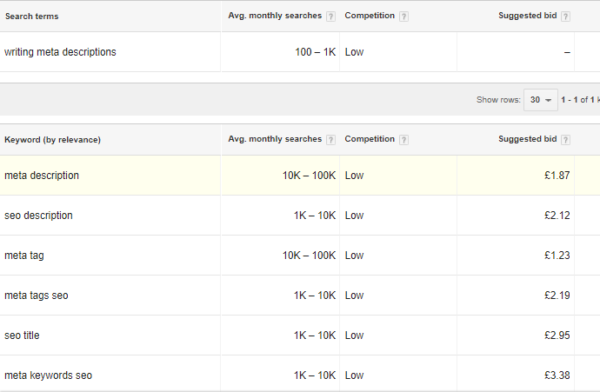— November 16, 2017
Are you looking for a way to craft a search strategy that boosts your rankings? Perhaps you’re wanting to entice more searchers to click-through to your site when it’s displayed in search results.
Crafting highly-converting meta tags will help you achieve both of these goals.
I’m sure you’re asking yourself, “But what exactly are these meta tags and what should I put in them?”
Meta tags tell a search engine (and more importantly, a searcher!) what your site is about. These simple tags are broken down into two elements: meta titles and meta descriptions.
Here’s an example of the meta information used on Business2Community homepage:

Tip: Get this by doing a site search in Google and entering [site: URL.com] into your search box.
The blue section is the meta title. This is one of the main factors in a search engine algorithm that helps it understand what the page is about.
The green section is your URL. This is not part of the meta data for your page, but it does help if your URL contains a keyword (particularly for category or product pages!).
Finally, the grey text is your page’s meta description. This is where you’ll have 160 characters to try and convert the searcher into clicking through. It has the most influence on click-through-rate (CTR), so use it as an opportunity to set your brand apart from other competitors that are listed in search results.
You’ll need to create meta tag information for every page on your website. That includes:
- Your homepage
- Category pages
- Product pages
- Service pages
- Blog posts
- And any other pages
The effect of meta tags for SEO
Meta tags aren’t just used for vanity reasons. While some examples do look great in a set of search results, meta tags have the potential to be a major game-changer for your SEO strategy.
Title tags
A title tag has a huge effect on SEO because it’s essentially giving a search engine a brief outline of what the page is about – and what it should rank for. You should always insert a title tag for every page you publish.
For home pages, the title tag will usually be your brand name and/or tagline. Category pages differ slightly and include the category name, as well as keywords with higher search volumes. Blog posts vary even more, with the majority of articles using the headline as their title tag.
Your title tag will show in the SERP results, as well as your social media platforms. So, you’ll need to make sure that it’s well-optimised, well-written and accurate. If not, you run the risk of being penalised for clickbait-type content (which is not good for anyone…so don’t do it!).
Descriptions
In 2009, Google announced that meta descriptions don’t have any ranking power in their search algorithm. But that’s not entirely that straightforward.
An increasing number of search engines, including Google, are rewarding sites that offer a great user experience. In other words, you could be penalised if your site is littered with clickbait meta descriptions that lead people straight off your page because they’ve not been provided with information relevant to their search.
On the other hand, you’ll be rewarded for creating meta information that explains exactly what the page is about. Properly utilising your meta descriptions is a fantastic way to boost the experience that a user has on your site. In return, your rankings could surge.
Getting precise with your ideal audience and clearly explaining what they’ll get before clicking through will filter out the ones who may have landed there when searching for something totally unrelated. (Plus, you should also see a massive increase in the time spent on site if you manage to craft an effective, well-written meta description!)
In short, although meta descriptions and SEO aren’t directly related, you can use persuasive copywriting to ensure that other algorithm ranking factors are boosted.
Which keywords should I target in my meta tags?
Now that we’ve come to grips with understanding how important these factors are for your SEO strategy and your users, you might be rearing to go. But there’s one little thing that you need to factor into your strategy that will have a huge impact on its success: keywords.
Keywords, also referred to as ‘search terms’, are defined as what you want the page to rank for. A keyword is usually the name of your product or service. However, there are tonnes of variations on any one keyword that you should research before writing your meta information.
An example: you may search for “how to write a meta tag”. I might search “writing meta tags”.
To combat these variations of search terms, use a tool like Google Keyword Planner to get ideas. Here’s what came up when I did the research for this article:

Based on these results, I targeted the keywords with substantial search volumes in my meta tags. A lot of people are looking for information on this topic, so make sure that your tags are optimised to reach them!
It’s also a good idea to browse and consider the keywords your competitors are using, just to double-check that you haven’t missed any.
When you get results for your own topic, I suggest picking one focus keyword and between two and four secondary ones. Sorting them in order of search volume or ranking difficulty can be a good way to prioritise them, but remember that accuracy is key. Always make sure that your focus keyword is exactly what you offer – not something you “kind of” do.
How to write a meta title
Now we’re ready to start writing! After you’ve done your keyword research, writing a meta title is fairly easy because the majority of the legwork has already been done.
Meta titles should be written to include:
1. Your focus keyword
As we mentioned earlier, the keyword research that you’ve done for your page should leave you with a range of keywords. But don’t fall into the trap of using them all in your title tag.
Keyword stuffing could actually have an adverse impact on your site’s rankings. If a search engine sees that you’re trying to rank for everything, they could see your site as spammy. Would Google really want to refer their searchers to something that could potentially ruin their own hard-earned reputation?
Having multiple keywords in your title tag will also reduce the “SEO power” that it has. One well-written keyword will be much more beneficial than having three of a lower quality!
Instead, choose your focus keyword and use it as the only keyword in your title. Here’s a great example of this done well by QuickBooks:

The aim of the page is for QuickBooks to sell their software that allows businesses to create invoices. So, they’ve started their meta title with the words “invoicing software” (which is likely to be their primary keyword).
You’ll also spot they’ve included the words “small business” in this tag, too. This gives the search engine and the user a clear overview of the software.
If a small business owner was to find this in their search results, they’ll have a high probability of clicking-through because they know it’s made exactly for them. Remember, accuracy is key. No clickbait here!
2. Your brand name
You’ll also want to put your brand name in your meta title. Not only will this help a searcher recognize your business if they see you ranking, but it boosts brand awareness.
If people already have a connection with your business (or have heard good things about you!), it can also help encourage them to click-through.
How to write a meta description
Meta descriptions are your chance to ‘advertise’ your business. After all, you are trying to make a searcher click your site instead of someone else’s!
This meta tag is one of the main influences in your CTR. Use these tips to make sure that your meta descriptions actually convert searchers into website visitors:
1. Calls-to-action
Is there any better way than to ask your customers to do something than actually asking? Marketers are great at coming up with innovative ways to get their target customer to do something, but sometimes, the most effective way is to just ask.
Include a call-to-action (CTA) in your meta description to do exactly this. Here’s a great example by Planner Pads:

They use the introductory part of their meta description to ask a question that their ideal customer is searching for, followed with a solution: their product.
The meta description concludes with, “Rollover to see how it works”. It’s simple, to-the-point and encourages you to click through. Instead of using boring words like ‘click’ or ‘find out’, they use something different. It sets them apart from their competitors and encourages someone to take action by clicking.
2. USPs
Unique selling propositions set you apart from your competitors. They’re especially valuable for search results where you’re encouraging a searcher to pick your site over any others!
USPs can be anything from your free delivery offer to the fact that your products are made with the best materials available. Whatever it is, include it in your meta description to give people a reason to choose you.
Here’s a great example of how LaptopsDirect have included their USPs (free next-day delivery) into their meta description:

They also use the words ‘biggest range’ and ‘affordable laptops’ to get over two pain points that their ideal customer might have: limited selection and products that are too expensive.
As you can see, some thought should be put into your meta tags before you upload them to your site. Make sure that your keywords are well-researched and remember that accuracy is key. Creating meta tags correctly and effectively should help you see a surge in ranking positions, website traffic and customers! Properly-utilised meta tags can have a huge impact on any business.
Digital & Social Articles on Business 2 Community
(125)
Report Post




